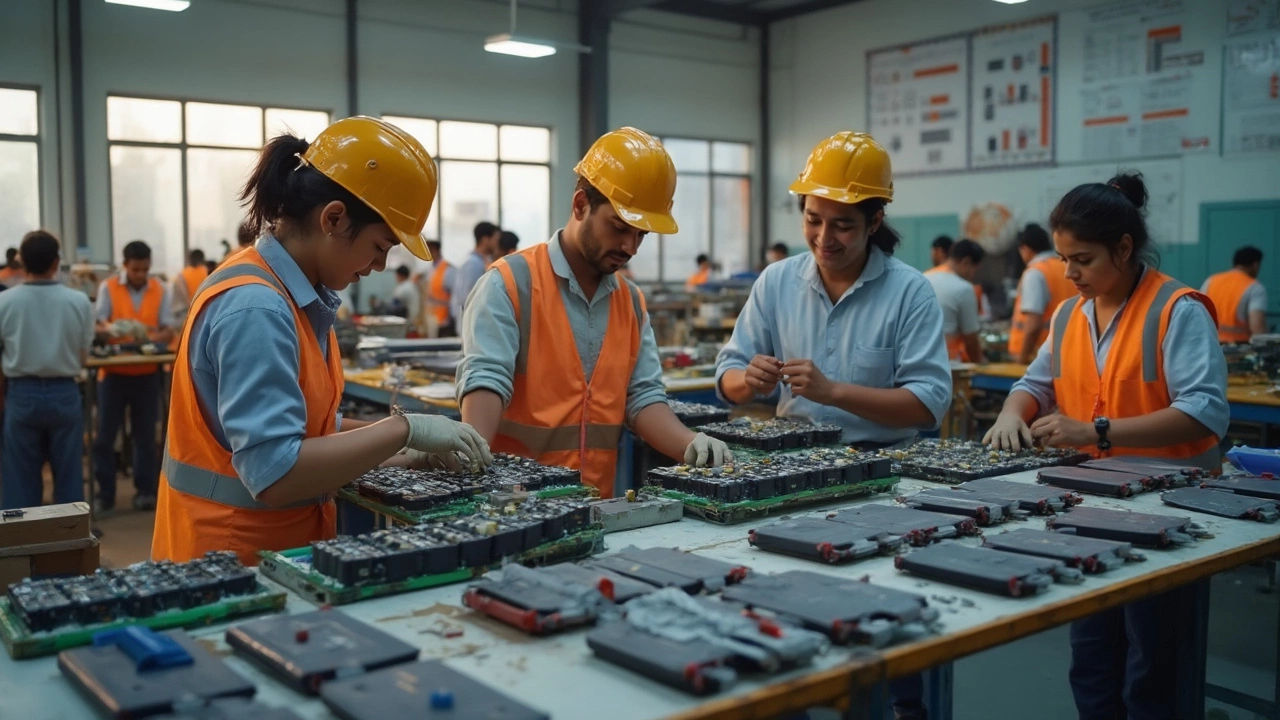Walk down any street in Delhi or a mall in Bangalore and you’ll spot it — people glued to their phones, shops packed with gadgets, delivery bikes loaded with boxes labeled ‘electronics.’ It’s not just hype. Electronics are almost a daily necessity now in India, and demand is still climbing.
If you’re wondering what’s really flying off the shelves, it’s not just about the latest flagship phones. There’s a whole mix: budget smartphones, smart TVs, audio gadgets, wearable devices, and now, even batteries for electric scooters and cars. Rural families might be buying basic mobile phones for the first time, while city folks swap smartwatches like they’re fashion accessories.
But high demand doesn’t mean it’s easy cash for manufacturers. Getting enough quality parts is a struggle. Labor costs are changing, factory space is tight, and shipping can throw surprise curveballs (especially when a cargo container gets stuck at a random port). Think you can just pick a product and make a fortune? It’s way more complicated than that.
- The Current Electronics Craze
- What’s Hot: Top-Selling Electronics
- The Manufacturing Struggle
- Money Talks: Profit and Pitfalls
- Tips for Manufacturers and Investors
The Current Electronics Craze
India’s appetite for electronics is honestly wild. In 2024, the country ranked as the second-largest smartphone market, right behind China. Every year, millions of new buyers enter the market—urban Gen Z folks snapping up 5G phones, rural families choosing reliable feature phones, and students switching from basic laptops to tablets for school. There’s a gadget for everyone, and that keeps things moving fast.
The biggest shift? Electronics are not just urban luxuries anymore. Internet packages in small towns are dirt cheap, which means even first-time buyers are going straight for smart devices. People stream, shop, and bank online everywhere, so more affordable smart TVs, budget phones, and small home appliances are in crazy demand right now.
Retailers and e-commerce companies like Flipkart and Amazon see massive sales spikes during the festive season. Just look at this breakdown of units sold in 2024 across top categories:
| Category | Units Sold (2024) |
|---|---|
| Smartphones | 162 million |
| Smart TVs | 16 million |
| Laptops/Tablets | 9.2 million |
| Wearables | 51 million |
| Home Appliances | 34 million |
Notice the spike in wearables and smart TVs. A chunk of this is from small towns where people want a bigger screen for online classes or binge-watching cricket. Urban customers, on the other hand, look for fitness bands, wireless earbuds, and home automation gadgets—think Alexa and connected lights.
If you’re thinking electronics is only about gadgets, guess again. With the push for electric vehicles, batteries and power electronics are shooting up in demand. Local companies are scrambling to set up new factories to keep up.
The electronics manufacturing India sector has exploded—partly because of Make in India policies, but mostly because demand is so relentless. The competition is stiff, but the opportunities are everywhere, from affordable devices for first-time buyers to high-tech tools for pros.
What’s Hot: Top-Selling Electronics
No surprise here—electronics manufacturing India is all about what Indians are buying by the millions. Smartphones lead the race, and the numbers back it up. In 2024, India shipped out over 170 million mobile phones, with Xiaomi, Samsung, and Vivo taking the biggest pieces of the pie. Even in smaller towns and villages, demand for reliable budget smartphones is steady, since more folks rely on internet banking, online classes, and even government health apps.
Smart TVs are close behind. People want bigger screens at home and features like Netflix pre-installed, so Indian factories have ramped up local production. In fact, smart TV shipments grew 13% last year, hitting almost 17 million units.
- Smartphones: Entry-level to mid-range dominate, but there’s a growing crowd for 5G models as data costs drop.
- Smart TVs: Consumers want big, affordable screens, smart features, and easy streaming.
- Laptops and Tablets: Post-pandemic work-from-home and online learning pushed sales up by nearly 20% in 2023.
- Wearables: Budget fitness bands and smartwatches are everywhere, with Indian brands like Noise and boAt battling it out with global names.
- EV Batteries: Electric scooter and car battery pack demand has tripled since 2022, especially with more Indians shifting to electric two-wheelers.
| Product | 2024 Shipments (million units) | Top Brands |
|---|---|---|
| Smartphones | 170+ | Xiaomi, Samsung, Vivo, Realme, Oppo |
| Smart TVs | 17 | Xiaomi, Samsung, OnePlus, Sony, TCL |
| Laptops/Tablets | 15 | HP, Dell, Lenovo, Acer, Samsung |
| Wearables | 55 | boAt, Noise, Fire-Boltt, Xiaomi, Samsung |
| EV Batteries | 5* | Exide, Amara Raja, Tata, local startups |
*EV battery numbers are much smaller than phones, but growth rate is off the charts—triple what it was two years back.
One more thing: Indian buyers care a lot about after-service and easy repairs. Gadgets that have quick service centers or spare parts get snapped up much faster. Don’t ignore that if you plan to manufacture or sell here.

The Manufacturing Struggle
Making electronics in India isn’t a walk in the park. Sure, the market is booming, but building gadgets at the right price and quality is a daily hustle. Let’s break down why this happens and what you’re up against if you want to dive in.
The biggest headache? Getting high-quality components. Most semiconductor chips, fancy displays, and batteries still come from outside India. The country imports about 60% of its electronic components, mostly from China, Taiwan, and South Korea. When supply chains slow down — like during COVID or last year’s shipping crisis — production lines grind to a halt. There’s no way to sugarcoat that risk.
Lack of skilled labor is another sore spot. India has loads of smart engineers, but not enough workers trained for high-tech assembly, especially for stuff like smartphones, wearables, or electric vehicle batteries. Training programs are popping up, but right now, factories in Noida, Chennai, and Bengaluru are having a tough time filling certain roles.
Costs don’t help either. Unlike countries like Vietnam or Indonesia, local middlemen, multilayered taxes, and land lease issues can pop costs up quick. Even with incentives like the Production-Linked Incentive (PLI) scheme, smaller players struggle to compete with established global giants.
Also, let’s talk regulations — from GST to sudden customs rule changes, manufacturers often need a crash course just to keep up. If you miss a paperwork deadline or mess up an import code, your materials might hang in customs for weeks.
For context, have a look at this quick snapshot of what manufacturers face in India’s electronics scene:
| Factor | India | Vietnam | China |
|---|---|---|---|
| Component Import Dependency | ~60% | ~40% | <20% |
| Labor Cost (avg, per hour) | $2.5 | $2.2 | $4.5 |
| Corporate Tax Rate | 22% | 20% | 25% |
| Time to Clear Customs (avg days) | 12 | 6 | 4 |
So, if you’re eyeing electronics manufacturing India as your next venture or investment, know this: surviving here takes grit, patience, and a scanner for red tape. The demand is massive — but keeping up with it is pure hustle.
Money Talks: Profit and Pitfalls
Making money in electronics manufacturing India sounds like a dream, but the real picture is both exciting and tough. While the demand for gadgets is wild, profits aren’t always guaranteed. Margins are tight, competition fierce, and one wrong move can hurt your bottom line fast.
Let’s crunch some numbers. Manufacturing profit margins for smartphones in India can hover around 5-8% for big local players—much lower if you’re dealing with price wars or launching a new model. Compare that with TV production, where margins are even slimmer, sometimes 2-4%. Accessories like chargers, smartwatches, and earphones bring in better slices, often up to 18% if the branding is strong and supply chains run smooth.
But it’s not all sunshine. Here are some common profit killers:
- Price Pressure: India’s market is extremely sensitive to price. Cutthroat discounts or ‘flash sales’ can backfire, hurting long-term profits.
- Import Costs: Many vital components are still imported, which means currency swings and tariffs can wipe out gains overnight.
- Low-cost Rivals: Competing with Chinese brands or cheap knockoffs is brutal, especially in phones and small devices.
- After-sales Service: Repairs, returns, and warranty claims eat into profits if not managed smartly.
Check out this quick comparison of common electronics segments:
| Product | Typical Margin | Biggest Risk |
|---|---|---|
| Smartphones | 5-8% | Price wars |
| TVs | 2-4% | Supply chain delays |
| Accessories | 10-18% | Counterfeit goods |
| EV Batteries | 8-11% | Import taxes and tech updates |
If you want to avoid major pitfalls, keep an eye on costs, move fast when trends shift, and don’t ignore brand building or quality control. A strong local supply chain helps, too—less dependency on imports means more stable profits and fewer surprises from global chaos.

Tips for Manufacturers and Investors
If you’re thinking about jumping into India’s electronics manufacturing game, there are things you just can’t ignore. The market is fast, crowded, and not for people who hope to wing it. Here’s what really matters if you want to make sure your business doesn’t get left behind.
- Localize Your Product: Don’t expect what works in the US or Europe to work here. In Tier 2 and Tier 3 cities, buyers want basic but reliable gadgets, while in metro cities, folks are swinging for premium features and global brands.
- Sourcing Matters: A recent study found that Indian electronics manufacturing units import almost 70% of their components, mostly from China, Vietnam, and Taiwan. Any hiccup in global logistics or new import duties can ruin your timeline and bite into profits. Build solid relationships with trusted suppliers and always have back-ups.
- Government Schemes: If you haven’t checked out the Production Linked Incentive (PLI) scheme, start now. The PLI has pulled in $2.1 billion USD in investments since 2022 and gives huge tax breaks and rebates on large production runs. Apply early because these quotas fill up fast.
- After-Sales Service: This trips up a lot of new brands. Consumers expect speedy repairs and local service centers. Set up strong after-sales support from the start—don’t leave this as an afterthought.
- Jump on E-commerce: Over 40% of electronics sales now happen through big sites like Flipkart and Amazon India. List your brand with top-rated sellers and take online reviews seriously—bad feedback kills more brands than you think.
Just to give a clearer picture, here’s what’s most in demand and where the big money is flowing:
| Product Type | Growth Rate (YoY) | Major Buyers |
|---|---|---|
| Smartphones | 9.8% | Urban & Rural |
| Smart TVs | 11.6% | Urban |
| Wearables | 18.4% | Urban (Youth) |
| EV Batteries | 15.7% | Urban & Tier 2 Cities |
If you’re struggling to decide where to put your money or get started, begin with products that match the needs of your target buyers—not just what’s trending offshore. Be ready for quick changes too. India’s electronics manufacturing scene can shift direction overnight when a major brand launches something new or a government policy changes.





Write a comment